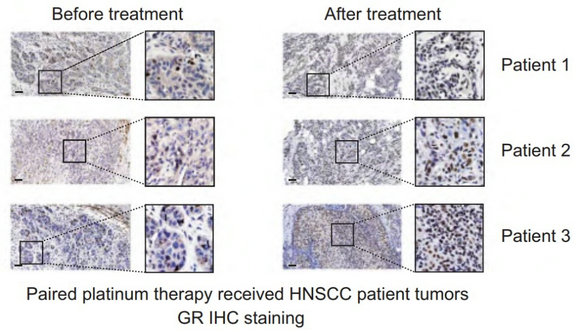Source: Zhongshan School of Medicine
Edited by: Zheng Longfei, Wang Dongmei
Platinum-based drugs are widely used first-line chemotherapy drugs for the treatment of various cancers including ovarian cancer, lung cancer, and head and neck cancer. They are known as the "penicillin of cancer". Among them, cisplatin is included in the WHO Model List of Essential Medicines and China's national essential medicines list. However, drug resistance and side effects have always plagued the clinical use of platinum drugs. In the early stage of treatment, some sensitive cancer cells develop resistance to cisplatin through the so-called acquired resistance, leading to severe tumor recurrence and patient death. Because platinum drugs are widely used in cancer treatment, systematic research on the mechanism of acquired resistance of platinum drugs has direct clinical translational value.
Glucocorticoid receptor (GR) is an important nuclear transcription factor that regulates the expression of related genes such as growth, development, metabolism, and immune response, and has an impact on a variety of life activities. In recent years, there have been some important reports about GR promoting the occurrence, development, and metastasis of tumors. In the inactivated state, glucocorticoid receptors are localized in the cytoplasm, and after binding to glucocorticoids or similar agonists, the nuclear localization sequence is exposed, which is then transported to the nucleus to regulate the expression of downstream genes. Platinum drugs such as cisplatin are higher-level chemotherapeutics that cause emesis. The chemotherapy-induced nausea and vomiting (CINV) caused by them is a common side effect in the clinical treatment of tumors, which seriously affects patient compliance. Synthetic glucocorticoids such as Dexamethasone can effectively alleviate the side effects such as nausea, vomiting and inflammatory pain caused by chemotherapy drugs and are used simultaneously with platinum chemotherapy. However, the function of glucocorticoid receptor in the formation of platinum resistance remains unclear.
Recently, Dr. Chaoyun Pan from the Department of Biochemistry, Zhongshan School of medicine, Sun Yat-sen University, published a research paper titled "Cisplatin-mediated activation of glucocorticoid receptor induces platinum resistance via MAST1" online in
Nature Communications, specifically studying the above issues. Dr. Pan’s team in Sun Yat-sen University have been focusing on the research of cisplatin resistance and previously reported the function of specific kinases in platinum resistance, which were published in the
Journal of Clinical Investigation in June 2019 and October 2019.
In the current research, Dr. Pan and others first established a mouse xenograft model of acquired cisplatin resistance, and through RNAseq analysis of differentially expressed genes, transcription factor array screening, chromatin immunoprecipitation and other experiments found in the process of acquired cisplatin resistance formation, GR drives the transcription of the key cisplatin resistance protein MAST1. Then the author found that cisplatin can induce the nuclear metastasis of GR in cell lines and patient tissues, suggesting that cisplatin leads to GR activation.

GR immunohistochemical staining in tumor tissues of matched head and neck cancer patients collected before and after platinum treatment. The figure shows a representative GR-stained image of the tumor of a patient with head and neck cancer
Then, through thermal transition analysis, surface plasmon resonance and other experiments, it was found that cisplatin can directly bind to the ligand binding domain (LBD) C622 site of GR to activate GR and have a synergistic effect with glucocorticoids. Professor Pan Chaoyun and others further discovered that the direct combination of cisplatin with C622 to activate GR and induce the expression of MAST1 kinase is the key factor leading to the resistance of cancer cells to cisplatin. Finally, experiments with a homologous mouse model of ovarian cancer abdominal cavity metastasis found that the use of MAST1 kinase inhibitors can effectively block glucocorticoid-induced cisplatin resistance.
The effect of MAST1 inhibitor lestaurtinib on tumor growth in an ID8-luc syngeneic mouse model treated with both cisplatin and dexamethasone
This study reveals the mechanism by which glucocorticoids cause acquired platinum resistance and proposes to target MAST1 kinase to block the formation of acquired platinum resistance caused by GR activation.
Link to the paper:
https://www.nature.com/articles/s41467-021-24845-8



